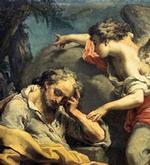Our Lady of La Leche
by Zsolt Aradi
St. Augustine, Florida, the oldest city on the North American continent, has many claims to fame. [St. John's, New Foundland is actually older; it is more accurate to designate St. Augustine as the oldest city in the United States. – ed.] It boasts of the oldest port in the country, the oldest wooden schoolhouse, and the oldest house; it possesses undeniably the oldest Catholic parish in the United States; the records in the cathedral date back to 1594. In addition, the flags of four nations have waved over the city and it has changed hands at least thirteen times; but, above all, it has the oldest and one of the most beautiful shrines dedicated to Our Lady.
It is certainly no exaggeration to say that this is the United States' most sacred ground. This was the first settlement on the North American continent. Others had tried but failed to establish themselves permanently. The mission Nombre de Dios (God's Name) remained along with this settlement.
On August 28, 1565, sailors of the great Admiral of Philip II's Spanish fleet, Don Pedro Menendez de Aviles, sighted land. August 28th was the feast day of St. Augustine and they decided that the community they intended to establish should be named after the great Bishop of Hippo. When they landed, on September 8, 1565, the day of the nativity of Our Lady, Father Mendoza Grajales, a missionary priest from Spain, offered the first parish Mass in the future United States. Other masses had been offered in America before, because other Catholic Spanish explorers carried Catholic chaplains with them, and these must have offered Mass whenever the expedition landed. There is no site, however, that marks their celebration of Mass because no communities sprang up as a result of their labors. Some years later, Catholic priests who came with the Spanish Admiral's ship established the first and oldest mission of the Catholic Church in the United States. They named it the mission of Nombre de Dios, the mission of the Holy Name of God. From this mission, priests were sent during the following two hundred years along the famous Santa Fe trail across northern Florida up through Georgia, the Carolinas, Alabama, Mississippi and finally as far as the Mississippi River. This important work of the mission of Nombre de Dios was begun forty-two years before the first English settlement, at Jamestown in Virginia; fifty-five years before the pilgrims set foot on Plymouth Rock; and about two hundred years before the founding of the California missions.
These first Spanish settlers, true to their traditions, brought with them a great love for Our Lady. Sometime between 1602 and 1620, they established on the grounds where Father Mendoza Grajales had offered Mass, the Holy Virgin's first sanctuary in the United States. They built a chapel and dedicated it to Nuestra Senora de La Leche y Buen Parto (Our Nursing Mother of Happy Delivery). They enshrined the little statue of the nursing, smiling and watchful mother in the small building. The Holy Virgin holds her Child with her right arm, and offers him her breast. The devotion to Our Lady of La Leche is one of the most ancient of all Marian devotions. The tender care for the helpless Child has inspired painters and sculptors for many centuries; the picture of Our Blessed Lady nursing the infant Jesus is one of the few pictures of the Virgin on the walls of Rome's catacombs. The form of this devotion spread particularly rapidly toward the end of the sixteenth century, and especially in Madrid.
When King Philip II became aware of Our Lady of La Leche's intercession, he ordered the erection of a shrine to honor her Motherhood. Arrival of the first settlers to the shores of St. Augustine coincided with the growth of this devotion.
The original image of Our Lady and the chapel at St. Augustine have been destroyed because the region was several times within range of battles. The present little chapel was begun in 1915 and the statue of Our Lady of La Leche is a replica of the ancient one. Recent excavations have unearthed what are believed to be the foundations for the first stone chapel built at the beginning of the seventeenth century. The original Spanish shrine which dated back to the sixteenth century and was erected by Philip II in Madrid was destroyed, together with the statue, by the communists on May 13, 1937 during the Spanish civil war.
The shrine of Our Lady of La Leche has been the center of devotion to thousands of mothers and mothers-to-be in recent years, and on the birthday of the Holy Virgin, the shrine is the scene of venerations that remind one of its old splendor. In the heart of the sanctuary there is a little stone chapel; not far from it, in the open air, stands an altar of palmetto logs on the same spot where the first Mass was offered.
This item 3185 digitally provided courtesy of CatholicCulture.org






